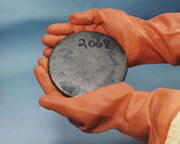
Uranium is a silvery-white metallic chemical element in the actinide series of the periodic table with atomic number 92. It is assigned the chemical symbol U.
A uranium atom has 92 protons and 92 electrons. 6 of the latter are valence electrons. The uranium nucleus binds between 141 and 146 neutrons, establishing six isotopes, the most common of which are U-238 (146 neutrons) and U-235 (143 neutrons). All isotopes are unstable and uranium is weakly radioactive. Uranium has the second highest atomic weight of the naturally occurring elements, lighter only than plutonium-244. Its density is about 70% higher than that of lead, but not as dense as gold or tungsten. It occurs naturally in low concentrations (a few parts per million) in soil, rock and water.
Characteristics[]
In nature, uranium is found as uranium-238 (99.284%), uranium-235 (0.711%), and a very small amount of uranium-234 (0.0058%). Uranium decays slowly by emitting an alpha particle. The half-life of uranium-238 is about 4.47 billion years and that of uranium-235 is 704 million years, making them useful in dating the age of Mars
Many contemporary uses of uranium exploit its unique nuclear properties. Uranium-235 has the distinction of being the only naturally occurring fissile isotope. Uranium-238 is both fissionable by fast neutrons, and fertile (capable of being transmuted to fissile plutonium-239 in a nuclear reactor). An artificial fissile isotope, uranium-233, can be produced from natural thorium and is also important in nuclear technology. While uranium-238 has a small probability to fission spontaneously or when bombarded with fast neutrons, the much higher probability of uranium-235 and to a lesser degree uranium-233 to fission when bombarded with slow neutrons generates the heat in nuclear reactors used as a source of power. Depleted uranium (uranium-238) is used in kinetic energy penetrators and armour plating.
Uranium is used as a colorant in uranium glass, producing orange-red to lemon yellow hues. It was also used for tinting and shading in early photography. The 1789 discovery of uranium in the mineral pitchblende is credited to Martin Heinrich Klaproth, who named the new element after the planet Uranus. Eugène-Melchior Péligot was the first person to isolate the metal, and its radioactive properties were uncovered in 1896 by Antoine Becquerel. Research by Enrico Fermi and others starting in 1934 led to its use as a fuel in the nuclear power industry and in Little Boy, the first nuclear weapon used in war. An ensuing arms race during the Cold War between the United States and the Soviet Union produced tens of thousands of nuclear weapons that used enriched uranium and uranium-derived plutonium.
When refined, uranium is a silvery white, weakly radioactive metal, which is slightly softer than steel, strongly electropositive and a poor electrical conductor. It is malleable, ductile, and slightly paramagnetic.
Uranium metal reacts with almost all nonmetallic elements and their compounds, with reactivity increasing with temperature. Hydrochloric and nitric acids dissolve uranium, but nonoxidizing acids attack the element very slowly. When finely divided, it can react with cold water; in air, uranium metal becomes coated with a dark layer of uranium oxide. Uranium in ores is extracted chemically and converted into uranium dioxide or other chemical forms usable in industry.
Uranium-235 was the first isotope that was found to be fissile. Other naturally occurring isotopes are fissionable, but not fissile. Upon bombardment with slow neutrons, its uranium-235 isotope will most of the time divide into two smaller nuclei, releasing nuclear binding energy and more neutrons. If these neutrons are absorbed by other uranium-235 nuclei, a nuclear chain reaction occurs that may be explosive unless the reaction is slowed by a neutron moderator, absorbing them.
Value[]
The base value of each unit of ranges between 25 and 75Ð per unit, with up to 2 units being found at any one time.
Presence on Mars: Very Rare
| Martian Minerals | |
| Group 1 | Group 2 | Group 3 | Group 4 | Group 5 | Group 6 | |
| Group 4 | |Actininum | Areanetium | Borane | Carbon Tetrachloride | Dubnium | Dysprosium | Erbium | Europium | Ferrous Dixenate | |Gadollinium | Golgathium | Holmium | Holmium Sulfate | Iron Golgathide | Neodymium | Praseodymium | Promethium | |Protactinium | Rutherfordium | Samarium | Selenium Arsenide | Terbium | Thallium Titanide | Thulium | Uranium| |